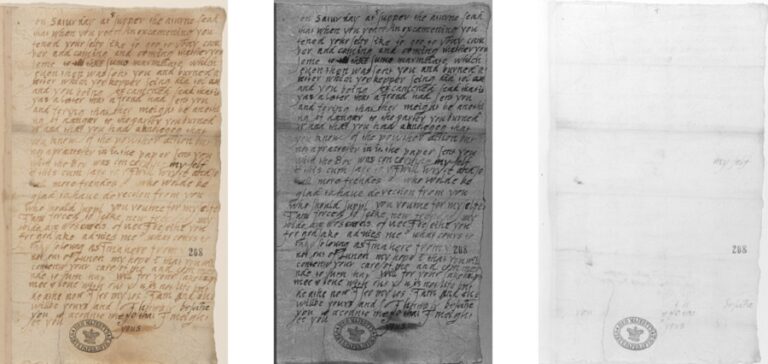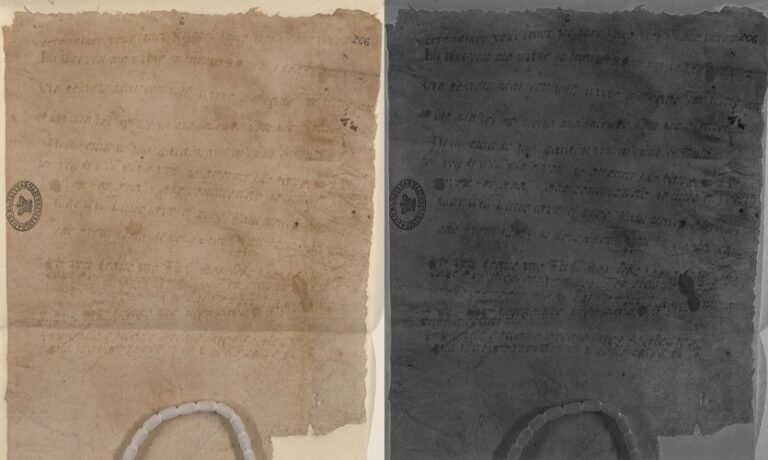When The National Archives’ Collection Care Department purchased a multispectral imaging system last year, we were excited by the many possibilities this instrument would offer us to improve access to our collection and enhance our research.
A multispectral imaging system captures images in specific ranges of light across the electromagnetic spectrum, and enables us to extract information not visible to the human eye. In recent years advanced imaging techniques, like multispectral imaging, have become widely used tools for investigating heritage objects, and our system enables us to improve the readability of documents with faded inks, identify pigments and dyes, and detect underdrawings – to name just a few applications.
A group of documents that caught my eye early on as something that could be investigated using multispectral imaging were letters written in invisible ink for clandestine communication, most notably the letters written in orange juice relating to the Gunpowder Plot. Katy Mair explains in her blog The Gunpowder and Orange Juice Plot that orange juice fades on drying, and only becomes visible once the paper is warmed. Henry Garnett, a Jesuit priest executed for his complicity in the Gunpowder Plot, frequently used this covert tactic to communicate with his associates while he was imprisoned in the Tower of London.
To celebrate Guy Fawkes Night I wanted to share examples of how I have used multispectral imaging to improve the readability of letters written in orange juice, and show too why these ‘inks’ are visible in some regions of the electromagnetic spectrum but not in others.
The first example is a letter written by Henry Garnett to Ambrose Rookwood – alias Thomas Sawyer (SP 14/216/2 item 242). The letter contains two types of ink: the orange juice ‘secret ink’ and iron gall ink, the most commonly used ink at the time.

Both inks are visible in a RGB colour photograph to varying degrees (top left) but imaging in the ultraviolet (UV) region of the electromagnetic spectrum increases the readability of the orange juice (top right).
To image this way, the letter is illuminated with UV light and the reflected UV light is recorded. Both the orange juice and iron gall ink absorb UV light, making the inks appear darker. Reflectance images appear on a greyscale but by combining a RGB colour photograph with a UV reflectance image we can create a false colour image (bottom left). These images keep the luminance of the UV image and blend it with the hue and saturation of the RGB colour photo, allowing for a more intuitive reading of the information on the letter.
The final image I took was an image in the infrared (IR) region of the electromagnetic spectrum (bottom right). Imaging in the IR region is frequently used to reveal underdrawings and concealed features. This is because the radiation penetrates deeper into the material and many materials, like organic pigments, become transparent.
In the IR region the orange juice completely disappears because it is an organic material. However the iron gall ink which contains iron salts is still partly visible, enabling us to clearly distinguish the two types of inks.
The second example where I used UV and IR imaging to distinguish between different inks is the letter from Anne Vaux to Garnett (SP 14/216/2 item 244). In the IR region, additions written in iron gall ink can be clearly distinguished from the now transparent orange juice. The UV image does enhance the visibility of the orange juice, but as we can see it is already, for the most part, readable in a RGB colour photograph.

The final example is the most illegible of the orange juice letters written between Vaux and Garnett (SP14/216/2 item 243). The UV does increase the readability of the ink, but the letter is still very difficult to decipher.

An interesting question that I cannot answer through imaging is why is this letter so much more illegible than the other letters? It’s likely a combination of the differences in the orange juice and paper used, the method of application and retrieval, as well as the different levels of degradation between the letters, but additional tests would be needed to clarify this.